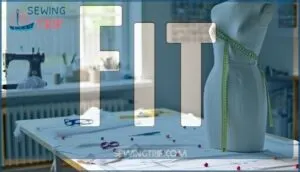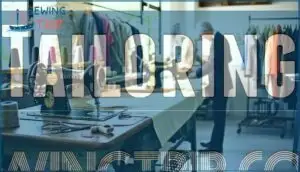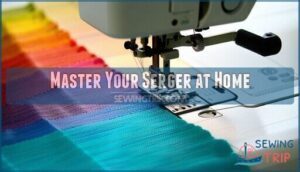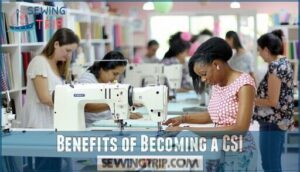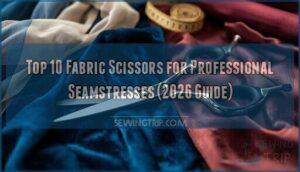This site is supported by our readers. We may earn a commission, at no cost to you, if you purchase through links.
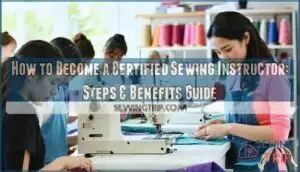
First, you’ll complete four core workshops: Fit, Pant Fitting & Sewing, Tailoring, and Master Your Serger at Home. Each workshop teaches advanced techniques you can’t learn from regular sewing classes.
After finishing the workshops, you’ll demonstrate your teaching skills and earn your CSI credentials. The process takes several months and requires ongoing education to maintain certification.
Once certified, you’ll join a professional community of instructors who can teach workshops and build credible sewing businesses. The specific requirements and insider strategies make all the difference.
Table Of Contents
Key Takeaways
- You’ll need to complete one of four Palmer/Pletsch workshops (Fit, Pant Fitting & Sewing, Tailoring, or Master Your Serger at Home) to qualify for their gold-standard Certified Sewing Instructor program.
- You’ll demonstrate your teaching skills after workshop completion, submit an application with a $39 fee, and maintain certification through annual renewal with 100 PDUs required yearly.
- You’ll gain immediate benefits including wholesale pricing on products, enhanced credibility with students, and access to exclusive teaching materials that help build your sewing business.
- You’ll join a professional community of instructors with opportunities to teach workshops, offer private lessons, develop online courses, and get listed in the official directory for increased visibility.
Become a Certified Sewing Instructor
Passion for sewing can transform into a rewarding teaching career through proper certification. Becoming a certified sewing instructor opens doors to teaching opportunities while building your reputation in the craft community.
Transform your love of sewing into a thriving teaching career that inspires others and builds your professional reputation.
The sewing instructor certification process begins with choosing the right training program. Palmer/Pletsch offers thorough instructor qualifications through their specialized courses. You’ll need to complete specific workshops like Fit, Pant Fitting & Sewing, Tailoring, or Master Your Serger at Home. Their Beginning Fashion Sewing Teacher Training workshop also qualifies you for certification.
This sewing instructor training focuses on skill development beyond basic sewing techniques. You’ll learn effective teaching methods and business practices. The certification costs include workshop fees plus an annual $39 renewal fee.
Career advancement becomes possible once you’re a certified sewing instructor. You’ll gain credibility that attracts students and creates new income streams. The sewing instructor certification requirements guarantee you’re prepared to guide others confidently through their sewing journey.
Qualify to Become a Palmer/Pletsch Certified Sewing Instructor
You’ll need to complete one of four specific Palmer/Pletsch courses to qualify for their certification program.
These courses include Fit, Pant Fitting & Sewing, Tailoring, or Master Your Serger at Home, and each one teaches you the Palmer/Pletsch system that you’ll later share with your students.
Each course is designed to teach you the Palmer/Pletsch system, which is essential for the certification program.
Fit
Mastering fit techniques forms the foundation of your sewing instructor certification journey.
You’ll learn essential fitting techniques including precise body measurements and pattern alterations that solve common sizing challenges.
The program covers muslin mockups for testing garments before cutting into expensive fabrics.
You’ll master common adjustments like bust, waist, and hip modifications that transform ill-fitting patterns into perfectly customized pieces.
This thorough sewing instructor training prepares you to guide students through professional fit analysis and become a certified sewing teacher.
Many patterns are based on outdated sizing standards, making fit adjustments vital.
Pant Fitting & Sewing
Pant fitting often trips up many sewers, but you’ll master essential skills like Pant Pattern Adjustments and smart Fabric Choices.
Your teacher training covers Seam Finishes, Pocket Construction, and Mastering Waistbands techniques.
This sewing certification path builds your pant fitting expertise systematically, and you’ll gain the sewing instructor qualifications needed to help others create perfectly fitted pants as a certified sewing teacher.
To achieve this, consider pursuing Palmer/Pletsch certification programs to enhance your skills.
Tailoring
Through tailoring certification, you’ll master professional techniques that transform ordinary fabric into perfectly fitted garments.
This pathway teaches fabric selection, custom fitting, and advanced garment construction methods.
You’ll learn pattern alterations and professional tailoring skills that clients demand.
The program covers alteration techniques and tailoring instruction methods essential for teaching others.
As a certified sewing instructor, you’ll confidently guide students through complex garment construction teaching with expertise that sets you apart.
Aspiring instructors can explore tailoring instructor training to gain essential skills.
Master Your Serger at Home
Serger mastery opens doors to advanced sewing instruction. You’ll develop threading mastery and stitch control through Palmer/Pletsch’s thorough training program.
Learn fabric manipulation techniques that transform ordinary seams into professional finishes. This sewing certification program covers essential serger techniques and project ideas.
Master your sewing machine expertise while meeting sewing instructor certification requirements for successful sewing teacher training programs. To guarantee proper function, understanding the serger threading process is key to ensuring your serger works correctly and that you can achieve serger techniques with ease.
Benefits of Becoming a CSI
Once you’ve met the qualification requirements, earning your CSI certification opens doors you never knew existed. This credential transforms your sewing passion into a legitimate business venture with tangible rewards.
Transform your sewing passion into a thriving teaching career with professional certification that opens endless opportunities.
Your new status brings immediate financial perks. You’ll enjoy wholesale pricing on Palmer/Pletsch products, which means more money stays in your pocket. The credibility boost is equally valuable – students trust certified instructors more than self-taught teachers.
This industry recognition helps you stand out in a crowded marketplace. Career advancement opportunities multiply once you’re certified. Business opportunities include teaching workshops, offering private lessons, or even developing online courses. The certification acts as your professional stamp of approval.
Sewing can also offer significant stress relief through its mindful and repetitive motions. Key benefits include:
- Access to exclusive teaching materials and ongoing support
- Free repeat training workshops to sharpen your skills
- Listing in the official instructor directory for increased visibility
Your investment in Sewing Instructor Certification Process pays dividends through enhanced earning potential and professional standing.
Steps to Become a CSI
Now that you know the perks, let’s walk through the Sewing Instructor Certification Process. Your journey starts with Course Completion in one of four specialized areas: Fit, Pant Fitting & Sewing, Tailoring, or Master Your Serger at Home.
After finishing your chosen program, Workshop Attendance at the corresponding teacher training session is mandatory. Next comes Application Submission. Download and complete the official Palmer/Pletsch form, then pay the $39 certification fee.
This step officially registers you as a Certified Sewing Instructor. Maintaining Certification requires annual renewal. You’ll need to meet Renewal Requirements by submitting the renewal form and paying the yearly fee.
The Sewing Teacher Training Programs provide ongoing support, ensuring you stay current with industry standards and teaching methods throughout your certification journey.
Earning PDUs
PDU Requirements form the backbone of your certification renewal process.
You’ll need 100 PDUs annually to maintain your credentials.
Workshop PDUs offer the fastest path – 5-day sessions provide 50 PDUs while 2-day workshops give you 20.
PDU Tracking becomes your best friend here, document every learning activity carefully.
Advanced PDUs come from mentoring others or presenting at conferences.
Sewing Instructor Professional Development isn’t just about meeting minimums – it’s about growing your skills.
Remember, Certification Renewal depends on consistent PDU accumulation throughout the year, and PDU accumulation is crucial for maintaining your credentials.
Frequently Asked Questions (FAQs)
How can I get a sewing certification?
Like planting seeds in fertile ground, you’ll cultivate expertise through specialized programs.
Complete Palmer/Pletsch workshops in fit or tailoring, or pursue Sewing & Craft Alliance’s three-day instructor training to earn professional certification.
Do I need to go to college to become a sewing instructor?
You don’t need a college degree to become a sewing instructor.
Professional certification programs like Palmer/Pletsch or Sewing & Craft Alliance offer specialized training that’s more relevant than traditional college courses for teaching sewing skills.
How can I become a sewing teacher?
Practice makes perfect when teaching others your craft.
You’ll master fitting, tailoring, or serger techniques through specialized programs.
Complete certification courses, attend workshops, and gain hands-on experience to become a qualified sewing instructor.
How can I become a sewing professional?
You can become a sewing professional by completing specialized training programs, earning certifications like Palmer/Pletsch CSI or TSI.
Mastering advanced techniques, and building business skills to establish credibility in the industry are also crucial steps.
Is a sewing certificate required to teach sewing?
You don’t need a sewing certificate to teach sewing, but it helps.
Certification builds credibility, opens doors to better opportunities, and shows you’re serious about your craft.
Students trust certified instructors more.
How can I start a sewing class?
Ready to turn your passion into purpose?
Start by choosing your niche—beginner basics, alterations, or specialized techniques.
Secure a teaching space, gather supplies, set competitive rates, and market through social media and local communities to effectively establish your presence.
How to become a sewing educator?
You’ll want to complete specialized training programs like Palmer/Pletsch certification or the Sewing & Craft Alliance’s TSI program.
These courses teach both sewing skills and business fundamentals you’ll need for success.
Is there a certification for sewing?
Yes, several certifications exist for sewing instructors.
You can pursue Palmer/Pletsch Certified Sewing Instructor credentials, the Sewing & Craft Alliance’s Trained Sewing Instructor program, or Master Sewing and Design Professional certification through various organizations.
What is a sewing teacher called?
A sewing teacher goes by several names: sewing instructor, seamstress instructor, fashion instructor, or textile arts teacher.
You’ll also hear certified sewing instructor (CSI) or trained sewing instructor (TSI) for professionally credentialed educators.
How to start teaching sewing lessons?
Start by getting certified through programs like Palmer/Pletsch or Sewing & Craft Alliance.
You’ll need solid sewing skills first. Then create lesson plans, gather supplies, and find students through local community centers or online platforms.
Conclusion
Starting your journey to become a certified sewing instructor is like threading a needle – it requires patience and precision, but the results are worth it.
You’ll gain valuable skills through Palmer/Pletsch’s four core workshops, build credibility in the sewing community, and open doors to teaching opportunities.
The certification process takes dedication, but you’ll join a professional network that supports your growth.
Take the first step today and discover how rewarding it can be to share your sewing expertise with others.
- https://palmerpletsch.com/become-a-sewing-teacher/
- https://sewingcertification.com/
- https://sewingfromhome.com/careers/sewing-teacher/
- https://www.sewingprofessionals.com/Certification-Programs
- https://arrowsewing.com/blog/unlocking-your-sewing-career-in-2024-sewing-professions-explained/?srsltid=AfmBOormrQvG423PRq0FoA2cTuCWBsJyAw8f7KKt9ZXdk7sHpnWN0Ytv

